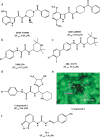Development of Small-molecule HIV Entry Inhibitors Specifically Targeting gp120 or gp41
- PMID: 26324044
- PMCID: PMC4775441
- DOI: 10.2174/1568026615666150901114527
Development of Small-molecule HIV Entry Inhibitors Specifically Targeting gp120 or gp41
Abstract
Human immunodeficiency virus type 1 (HIV-1) envelope (Env) glycoprotein surface subunit gp120 and transmembrane subunit gp41 play important roles in HIV-1 entry, thus serving as key targets for the development of HIV-1 entry inhibitors. T20 peptide (enfuvirtide) is the first U.S. FDA-approved HIV entry inhibitor; however, its clinical application is limited by the lack of oral availability. Here, we have described the structure and function of the HIV-1 gp120 and gp41 subunits and reviewed advancements in the development of small-molecule HIV entry inhibitors specifically targeting these two Env glycoproteins. We then compared the advantages and disadvantages of different categories of HIV entry inhibitor candidates and further predicted the future trend of HIV entry inhibitor development.
Conflict of interest statement
The authors confirm that this article content has no conflict of interest.
Figures





Similar articles
-
Recent Progress in the Development of HIV-1 Entry Inhibitors: From Small Molecules to Potent Anti-HIV Agents.Curr Top Med Chem. 2019;19(18):1599-1620. doi: 10.2174/1568026619666190712204050. Curr Top Med Chem. 2019. PMID: 31424370 Review.
-
The C4 region as a target for HIV entry inhibitors--NMR mapping of the interacting segments of T20 and gp120.FEBS J. 2015 Dec;282(24):4643-57. doi: 10.1111/febs.13541. Epub 2015 Oct 22. FEBS J. 2015. PMID: 26432362 Free PMC article.
-
Development of Protein- and Peptide-Based HIV Entry Inhibitors Targeting gp120 or gp41.Viruses. 2019 Aug 1;11(8):705. doi: 10.3390/v11080705. Viruses. 2019. PMID: 31374953 Free PMC article. Review.
-
HIV-1 Entry Inhibitors: A Review of Experimental and Computational Studies.Chem Biodivers. 2018 Oct;15(10):e1800159. doi: 10.1002/cbdv.201800159. Epub 2018 Sep 21. Chem Biodivers. 2018. PMID: 30027572 Review.
-
Biochemistry and biophysics of HIV-1 gp41 - membrane interactions and implications for HIV-1 envelope protein mediated viral-cell fusion and fusion inhibitor design.Curr Top Med Chem. 2011 Dec;11(24):2959-84. doi: 10.2174/156802611798808497. Curr Top Med Chem. 2011. PMID: 22044229 Free PMC article. Review.
Cited by
-
Anti-HIV and Anti-Candidal Effects of Methanolic Extract from Heteropterys brachiata.Int J Environ Res Public Health. 2021 Jul 7;18(14):7270. doi: 10.3390/ijerph18147270. Int J Environ Res Public Health. 2021. PMID: 34299720 Free PMC article.
-
Structure-Based Identification of Natural-Product-Derived Compounds with Potential to Inhibit HIV-1 Entry.Molecules. 2023 Jan 4;28(2):474. doi: 10.3390/molecules28020474. Molecules. 2023. PMID: 36677538 Free PMC article.
-
Conformational Stabilization of Gp41-Mimetic Miniproteins Opens Up New Ways of Inhibiting HIV-1 Fusion.Int J Mol Sci. 2022 Mar 3;23(5):2794. doi: 10.3390/ijms23052794. Int J Mol Sci. 2022. PMID: 35269936 Free PMC article.
-
Antibody-Mediated Therapy against HIV/AIDS: Where Are We Standing Now?J Pathog. 2018 Jun 3;2018:8724549. doi: 10.1155/2018/8724549. eCollection 2018. J Pathog. 2018. PMID: 29973995 Free PMC article. Review.
-
Structure-based identification of inhibitors targeting obstruction of the HIVgp41 N-heptad repeat trimer.Bioorg Med Chem Lett. 2017 Jul 15;27(14):3177-3184. doi: 10.1016/j.bmcl.2017.05.020. Epub 2017 May 8. Bioorg Med Chem Lett. 2017. PMID: 28558972 Free PMC article.
References
-
- Fischl MA, Richman DD, Grieco MH, Gottlieb MS, Volberding PA, Laskin OL, Leedom JM, Groopman JE, Mildvan D, Schooley RT. The efficacy of azidothymidine (AZT) in the treatment of patients with AIDS and AIDS-related complex. A double-blind, placebo-controlled trial. N Engl J Med. 1987;317(4):185–191. - PubMed
-
- Brook I. Approval of zidovudine (AZT) for acquired immunodeficiency syndrome. A challenge to the medical and pharmaceutical communities. JAMA. 1987;258(11):1517. - PubMed
-
- Gulick RM, Mellors JW, Havlir D, Eron JJ, Gonzalez C, McMahon D, Richman DD, Valentine FT, Jonas L, Meibohm A, Emini EA, Chodakewitz JA, Deutsch P, Holder D, Schleif WA, Condra JH. Treatment with Indinavir, Zidovudine, and Lamivudine in adults with human immunodeficiency virus infection and prior antiretroviral therapy. N Engl J Med. 1997;337(11):734–739. - PubMed
-
- Perelson AS, Essunger P, Cao Y, Vesanen M, Hurley A, Saksela K, Markowitz M, Ho DD. Decay characteristics of HIV-1-infected compartments during combination therapy. Nature. 1997;387(6629):188–191. - PubMed
-
- New York Blood Center. Synthetic peptides as inhibitors of HIV-1. 1992 US5,444,044.
Publication types
MeSH terms
Substances
Grants and funding
LinkOut - more resources
Full Text Sources
Other Literature Sources
Medical
